Physical Address
304 North Cardinal St.
Dorchester Center, MA 02124
Prenatal ultrasound of the fetal brain in the second and third trimester is described, from basics to advanced neurosonography.
Classification of central nervous system anomalies is discussed. The neurodevelopment stage determines some of the pathological conditions; others are related to external factors interfering with normal brain development.
The diagnosis of neural tube defects deserves attention in the light of potential fetal surgery.
Analysis of the anterior and posterior complex aids in the diagnosis of ventral induction disorders.
The size and position of the vermis is key in the differential diagnosis of posterior fossa anomalies.
The diagnosis and differentiation of cortical developmental anomalies remains challenging, but fetal magnetic resonance imaging overcomes some of the sonographic diagnostic challenges.
Destructive lesions are linked to intracranial bleeding, congenital infections, ischemic and vascular lesions and arteriovenous malformations.
Fetal cystic lesions and cerebral tumours may cause neurologic impairment because of the mass effect rather than the type of the lesion.
Some lesions are borderline but frequently encountered; usually if isolated, the prognosis is fairly good.
Congenital anomalies (CAs) of the central nervous system (CNS) account for 10.2% of all registered CAs and represent the fourth most common group of congenital malformations ( Table 28.1 ). The prevalence for all cases is 25.97 per 10,000 births. As many as 8.5% of CNS anomalies are related to a genetic condition. In contrast with the leading causes of CA, however, the number of live births is only about 44%. The majority of cases end in a termination of pregnancy (TOP) (52.4%) or a fetal death (3.5%). In addition, more than 10% of infant deaths secondary to CA worldwide are related to the CNS.
| Group of Congenital Malformation | Total Number | Prevalence Per 10,000 Births | Percent of Genetic Conditions | Percent Live Births |
|---|---|---|---|---|
| Heart defects | 22,709 | 76.46 | 15.0 | 87.6 |
| Urinary tract anomalies | 10,082 | 33.95 | 6.6 | 84.5 |
| Limb anomalies | 12,817 | 43.16 | 9.5 | 86.7 |
| Nervous system anomalies | 7712 | 25.97 | 15.0 | 44.1 |
Ultrasound examination in the second trimester as screening tool for the detection of structural brain lesions mainly relies on three historical planes: the transthalamic plane, the ventricular plane and the plane though the posterior fossa ( Figs. 28.1 to 28.3 ) The proper use of these planes in midtrimester ultrasound screening enables the detection of most of the major CNS malformations. Fetuses in which there is a suspicion of brain anomalies should be evaluated by dedicated fetal medicine specialists imaging the brain in the different orthogonal planes, transabdominally and transvaginally whenever possible ( Figs. 28.4 to 28.6 ). Additional imaging by three-dimensional (3D) ultrasonography may facilitate fetal brain exploration ( Fig. 28.7 ). Recently, automated algorithms have allowed for the recognition of the major essential landmarks in normal developing fetal brains. Novel and complementary magnetic resonance imaging (MRI) techniques after 24 weeks of gestation may enrich the detailed exploration of the fetal brain by ultrasound in some conditions.
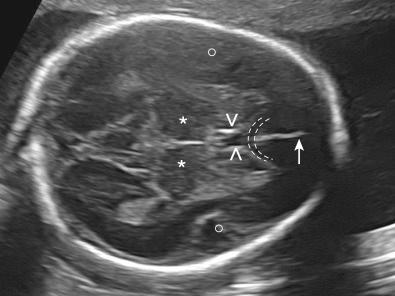
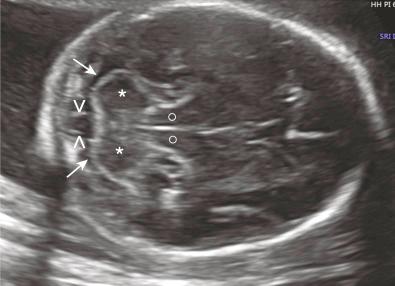
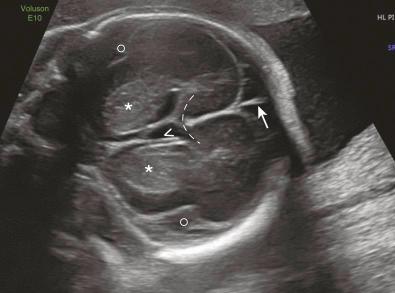
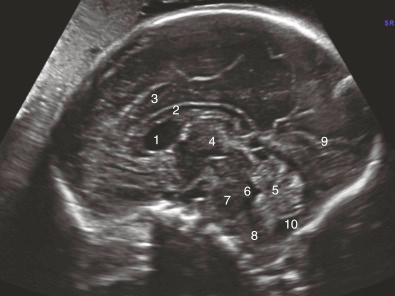
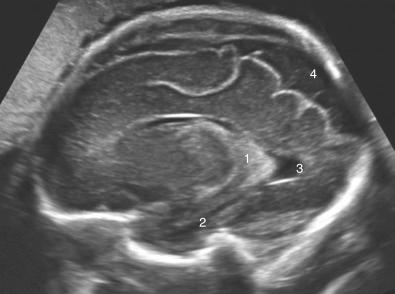
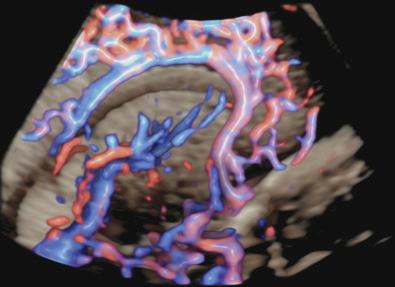
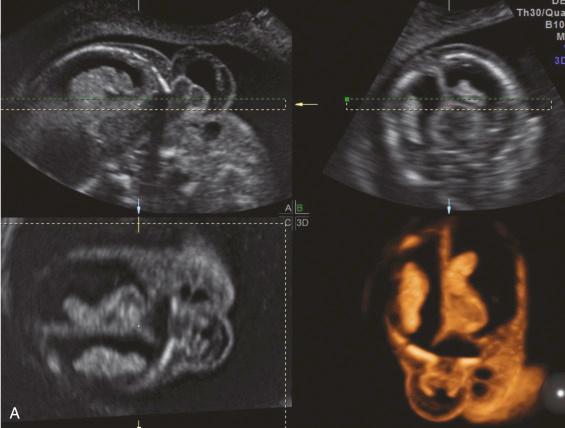
The International Society of Ultrasound in Obstetrics and Gynecology published practice guidelines about the performance of fetal MRI.
Fetal ventriculomegaly (VM) is an enlargement of the lateral cerebral ventricle caused by an excess of cerebrospinal fluid (CSF). The incidence of VM ranges from 0.3 to 1.5% life births. Unilateral VM occurs in 60% of the cases, leaving 40% bilateral. There is a male predominance (70%). VM may result from obstructive malformations, destructive lesions and abnormal development of the brain ( Table 28.2 ).
| Leading Cause of Ventriculomegaly | Anomaly | |
|---|---|---|
| Abnormal turnover of cerebrospinal fluid | Obstructive | Aqueduct stenosis |
| Spina bifida and cephaloceles | ||
| Intracranial haemorrhage | ||
| Arachnoid cyst | ||
| Tumours | ||
| Infections | ||
| Nonobstructive | Papilloma of the choroid plexus | |
| Structural malformations | Agenesis of the corpus callosum | |
| Holoprosencephaly | ||
| Destructive lesions | Infections | |
| Porencephaly | ||
| Vascular insults | ||
| Syndromes | Trisomy 21, 13 or 18 | |
| Miller-Dieker syndrome | ||
| Smith-Lemli-Opitz syndrome | ||
| Aicardi syndrome | ||
| Migration | Lissencephaly | |
| Schizencephaly | ||
| Megalencephaly | ||
| Microcephaly | ||
The diagnosis is made with the measurement of the lateral ventricle in a strict sagittal plane on ultrasonography. The measurement is performed opposite to the internal parieto-occipital sulcus, putting the callipers on the inner wall at its widest part and aligned to the long axis ( Fig. 28.8 ). An atrial width between 10 and 15 mm is considered mild VM; a width greater than 15 mm constitutes severe VM ( Figs. 28.9 and 28.10 ). Fetal MRI is helpful to diagnose additional abnormalities in 5% to 50% of the cases.
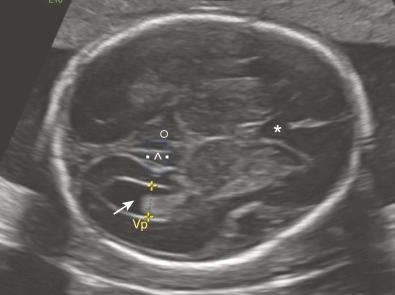
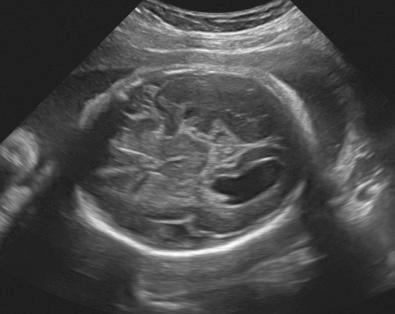
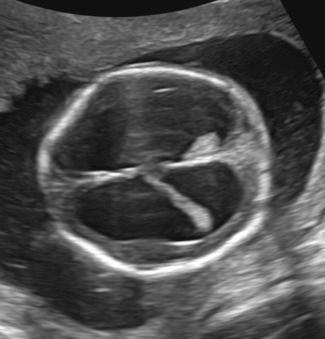
Fetal VM is often associated with CNS anomalies (agenesis of the corpus callosum [CC], spina bifida [SB]). In 30% of cases, severe VM is associated with non-CNS anomalies. Chromosomal anomalies are detected in more than 15% of cases when VM is associated with other fetal anomalies. In mild VM, structural anomalies range from 10% to 76%. However, even in apparently isolated VM, malformations are found in 13% of the cases after birth.
Ventriculomegaly associated with other brain anomalies carries a high mortality rate (60%–70%). Early detection and progression of the VM are bad prognostic factors. Isolated mild VM has a poor outcome in 20% of the cases with perinatal death in 1.4%. In 3% of cases with isolated mild VM chromosomal abnormalities are seen (mainly T21: 9 times more). Prenatal stabilisation in size or regression is a favourable sign. Recently, isolated mild VM documented by a normal fetal MRI has been associated with a normal neurodevelopment outcome when evaluated between 18 and 36 months of age by the Vineland Adaptive Behavior Scales. The same study demonstrated a similar result for moderate VM but on a rather small sample size and should be confirmed on a larger population.
Neural tube defects (NTDs) are caused by a failure of closure of the neural tube before the end of the sixth week of gestation at the two most vulnerable locations (i.e., the rostral and caudal neuropores). Dorsal induction failures are divided into open and closed defects and classified according to the level of the lesion.
Failure of the rostral and caudal neuropores to close during the primary neurulation results, respectively, in cranial and spinal open NTD. Failure of the canalisation during the secondary neurulation results in closed NTD. Causes of NTD are multifactorial, involving genetic and mainly epigenetic risk factors along with complex mechanisms.
At the spinal (caudal) level, an NTD is called spinal dysraphism or SB.
When a spinal column defect remains covered (closed SB) rather than open (open SB), fetuses do not develop the same severe sequelae. In its open form, SB presents as a progressive disease explained by the two-hit pathogenesis. First, there is the failed closure of the neural tube by the sixth week of gestation. Second, from 16 weeks onwards, there is secondary damage to the exposed spinal cord and nerves caused by direct trauma and neurotoxic agents in the amniotic fluid, as well as to the brain. The latter is evidenced by the development of VM and Chiari II malformation (CM) caused by CSF leakage at the level of the defect, leading to a ‘suction gradient’. A similar two-hit pathogenesis could explain the other types of NTD. For anencephaly, animal studies and case reports have shown that there is progression from acrania to exencephaly and finally anencephaly caused by secondary degeneration of the brain.
A study of long-term trends in prevalence of NTDs in Europe from 1991 to 2011 found that total prevalence fluctuates slightly but without an obvious downward trend. SB is the most frequent NTD with a total prevalence of 4.9 in 10,000 in Europe from 2008 to 2012 according to the European Concerted Action on Congenital Anomalies and Twins (EUROCAT) registry, 3.17 in 10,000 in the United States, 1.4 in 10,000 in Brazil, and 15.0 in 10,000 in Northern China. Anencephaly and encephalocele have, respectively, a total prevalence of 5.40 and 1.06 per 10,000 births in Europe. Thanks to primary prevention in North America using folic acid food fortification, the total prevalence rate of SB in the United States declined by 31% from the pre- (1995–1996; 5.04 in 10,000) to the postfortification period (1998–2006; 3.49 in 10,000). In addition, preconception folic acid supplementation might also reduce the severity of NTD.
Prenatal screening for NTD by ultrasound in Europe showed detection rates ranging from 25% to 94%, with an overall detection rate of 84%. Detection rates depend on the presence of standardised screening programs, the gestational age at which screening is performed and the type of lesion.
The three phases in the development of anencephaly are (i) a defective development of the cranial vault resulting from a failed closure of the rostral part of the neural groove, (ii) exposure to the amniotic fluid and involuntary fetal movements changing the developing brain to amorphous neurovascular tissue (exencephaly) and (iii) a disintegration of the brain tissue resulting in anencephaly.
Sonographically, exencephaly is recognised by the bulging brain above the orbits (the Mickey Mouse Face or the French bonnet sign). Early in gestation, therefore, the diagnosis may be missed because the crown–rump length (CRL) may be normal. Complete disintegration of the brain subsequently results in a short CRL for gestational age and the typical frog-like appearance of the fetal face caused by the absence of any structure above the orbits ( Figs. 28.11 and 28.12 ). Differential diagnoses are large encephalocele and amniotic band syndrome ( Fig. 28.13 ). Sonographic detection of anencephaly reaches 100%, most of which occurs now in the first trimester. Associated anomalies are present in 25% to 50% of the cases. In isolated cases, the risk for chromosomal defects is low.
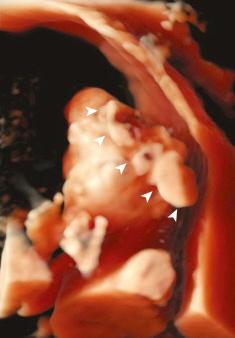
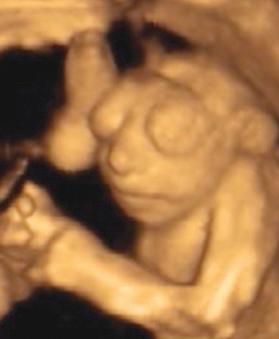
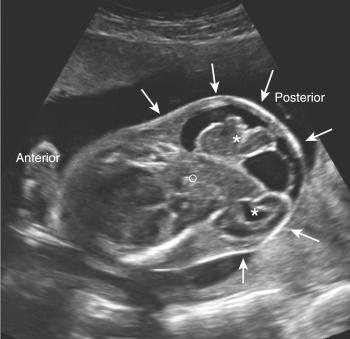
Anencephaly is fatal prenatally, intrapartum or within 48 hours of birth.
Cephaloceles result from a defect in the skull and dura mater with protrusion of meninges (cranial meningocele) or herniation of brain tissue covered by meninges (encephalocele). Their pathogenesis resulting directly from failure of neural tube formation has been contested. However, at present, these lesions are still considered postneurulation disorders. Cephaloceles are usually covered by skin or a thin epithelium layer, occur most frequently at the midline and may involve the occipital (75%–85%), frontal (12%), eccentric parietal (13%–15%) and interparietal regions. The size of the lesion may vary considerably; occasionally, the size of the encephalocele is larger than the fetal head, which, because of the herniation, becomes microcephalic.
Infants with encephaloceles, especially giant encephaloceles, present with additional cerebral and extracerebral malformations in 20% to 36.8% of the cases ( Table 28.3 ). Syndromic forms such as Merkel-Gruber syndrome and Walker-Warburg syndrome carry an increased recurrence risk. Chromosomal abnormalities are rare. Prenatal ultrasound has great potential in the early detection of encephaloceles, even in the first trimester. Efforts should be taken to highlight the associated malformations and offer invasive prenatal testing, particularly in nonisolated cases. Differential diagnosis includes amniotic band syndrome, iniencephaly, cystic hygroma and scalp cysts ( Fig. 28.14 ).
| Group | Anomalies |
|---|---|
| Central nervous system | Corpus callous agenesis, intracranial cysts, tectorial malformations, Dandy-Walker, cerebellar vermis agenesis, ventriculomegaly, hydrocephaly, grey matter heterotopia |
| Nonsyndromic | Ventricular septal defect, aortic coarctation |
| Cleft palate | |
| Tracheoesophageal fistula, gastroschisis, diaphragmatic hernia | |
| Costal malformations, talipes | |
| Pyelectasis, ureteral agenesis | |
| Chromosomal abnormality | Trisomy 13, trisomy 18, mosaic trisomy 20, 13q-, monosomy X |
| Syndromic forms | Meckel-Gruber syndrome |
| Walker-Warburg syndrome | |
| Knobloch syndrome | |
| Apert syndrome | |
| Fronto-facio-nasal dysplasia | |
| Oculo-encephalo-hepato-renal syndrome | |
| Vascular | Vertical positioned straight sinus, elongation of the vein of Galen, fenestration of the superior sagittal sinus |
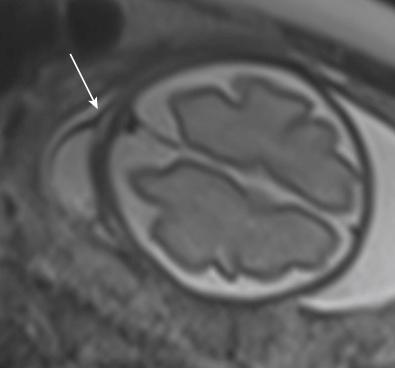
In isolated encephaloceles (73%–80%), the prognosis depends on the site, the size and the content of the lesion. In nonisolated cases, the mortality rate is as high as 79%. Surviving neonates present with neurologic impairment in 75% to 80% of the cases, including seizures and significant developmental delays. In giant encephaloceles, TOP may be offered. Microcephaly and hydrocephaly are good indicators of an impaired outcome.
Small lesions without brain tissue may have surgical correction with good outcome. Caesarean section is performed for the larger lesions containing brain tissue to prevent trauma.
Only 3% of NTDs display the most extreme form of primary neurulation failure: absent development of the cranial vault and defective closure of the vertebrae and skin. Sonographically, this lethal condition translates into an anencephaly with prolongation into a myeloschisis. Most cases end in early fetal loss ( Fig. 28.15 ).
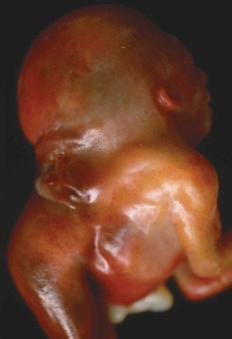
The aetiology of this lethal condition is unknown. Iniencephaly is a combination of a deficient occiput and inion, a rachischisis of the cervicothoracic spine and an extreme retroflexion of the head.
Sonographic appearance showed a fixed flexion of the head with an upturned face (stargazer appearance). Cervical and thoracic vertebrae show incomplete formation or closure; the occipital bones seem fused with the cervicothoracic vertebrae. Associated anomalies have been reported in more than 80% of cases.
Iniencephaly should be distinguished from extreme hyperextension of the fetal head, which may resolve spontaneously, and Klippel-Feil syndrome. Because of the hyperextension of the head, dystocia may occur. Early induction of labour should be considered to avoid Caesarean section.
The classification of spinal dysraphism has been revised recently as shown in Fig. 28.16 .
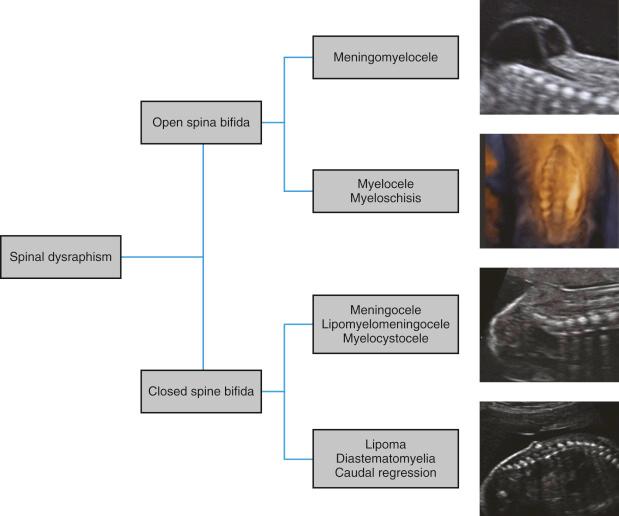
Open spinal dysraphism (OSD) consists of vertebral defects without skin coverage, exposing the neural tissue either directly to the amniotic fluid (myelocele or myeloschisis) or with coverage by a meningeal membrane (meningomyelocele).
Cerebrospinal fluid leaks into the amniotic cavity and may be responsible for the scalloping of the frontal bones (lemon sign on ultrasound). In addition, the cerebellum often herniates through the foramen magnum (Arnold-Chiari malformation type 2); obstructs the circulation of CSF, which may result in VM; and leads to reversal of the lemon sign after 24 weeks’ gestation ( Fig. 28.17 ). Reduced head circumference (HC) on ultrasonography is frequently part of the clinical spectrum of open NTD with 53% and 74% of the fetuses presenting with an HC below the 3rd and 10th centiles, respectively.
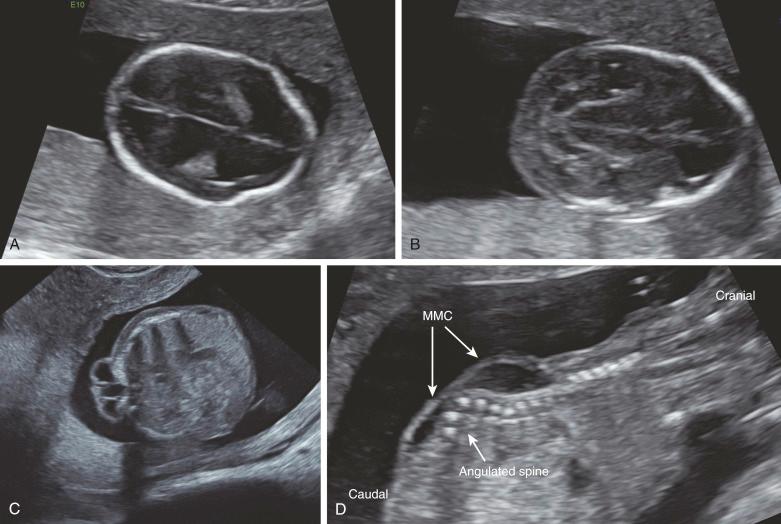
Screening for open NTDs by ultrasound relies on these cranial markers rather than on the direct features of the spinal lesion. In 99% of cases, at least one cranial marker is present before 24 weeks’ gestation ( Table 28.4 ). Other cerebral signs in the second trimester include the pointed deformity of the posterior horn, tectal beaking or elongation of the tectum or the presence of an interhemispheric cyst.
| <24 wk (%) | >24wk (%) | Overall (%) | |
|---|---|---|---|
| Lemon sign | 97–98 | 13 | 53 |
| Banana sign (small cerebellum) | 96–97 | 96 | 96 |
| Effaced cisterna magna | 93 | 93 | |
| Ventriculomegaly | 75 | 75–81 | |
| Small biparietal diameter | 61–74 | ||
| Ventricular point | >75 |
The identification and evaluation of the extent of the lesion demand sonographic exploration of the spine in all three planes (see Fig. 28.17 ). The 12th rib may serve as reference point to describe the level, although about 6% of fetuses display an abnormal number of ribs. Multiplanar 3D exploration of the spine and thoracic cage offers a standardised method of exploring and defining each vertebral level ( Fig. 28.18 ). Moving in the sagittal A plane, the B plane shows the axial view of the vertebral bodies and the overlying skin, which is the optimal view to identify the spinal defect. However, the bony defect does not always correlate with the functional level, prenatal prediction of the neurologic disability and functionality may be inaccurate.
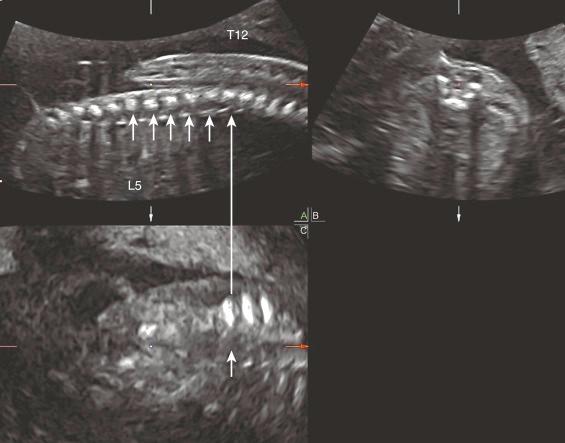
Recently, detection of open SB at the 11- to 13-week scan by visualisation of the intracranial translucency (IT) and posterior brain in the midsagittal plane gained increased interest. However, the sensitivity of these markers is low. In the hands of experts, the sensitivities of an absent IT and cisterna magna were 18% and 64%, respectively but increased significantly with the use of specific cutoff values to 45% and 73%, respectively. Other ultrasound features may enable a shift to first trimester diagnosis such as the reduction in the amount of intracranial CSF.
Fetal MRI has little additional value in the determining the level of the spinal defect, evaluation of the neural placode or detection of CM compared with experienced neurosonogram with high-resolution probes. This is due to the low spatial resolution of MRI compared with ultrasound, although this can be compensated with the high-contrast resolution. However, MRI is of value in the preoperative setting because of the essential anatomical information for the neurosurgeon before surgical planning. More subtle abnormalities such as callosal dysgenesis, periventricular nodular heterotopia, cerebellar dysplasia, syringohydromyelia, diastematomyelia and destructive lesions are more easily identified on prenatal MRI. The neurologic impairments associated with open NTDs are shown in Table 28.5 .
| Open NTD | Lethal | Neurologic Impairment at Cranial Level | Neurologic Impairment at Spinal Level |
|---|---|---|---|
| Anencephaly | Yes a | Absence of cerebral hemispheres function | Absence of spinal cord function |
| Encephalocele | No | Mild (anterior EC) to severe (posterior EC) cerebral dysfunction:
|
Absent or mild (anterior EC) to severe (posterior EC) spinal cord dysfunction:
|
| Open SB (MMC and myeloschisis) | No | Absent to moderate cerebral dysfunction:
|
Mild to severe spinal cord dysfunction:
|
Closed NTD are characterised by vertebral defects covered by skin. In the classification proposed by Tortori-Donati lesions are subcategorised into defects with a subcutaneous mass and lesions without a subcutaneous mass. In the absence of a subcutaneous mass, lesions are often missed prenatally.
The spinal cord is fixed in the vertebral canal because of adhesions, resulting in a limited or absent ascent of the tip of the medullar cone. During fetal development, the vertebral spine grows faster than the spinal cord, so that the medullar cone ascends from L3 and L4 at weeks 13 to 18, to L2 between 20 and 24 weeks.
Tethered cord syndrome can be congenital or acquired due to a complication of spinal injury or in relation to an NTD.
The conus medullaris presents on ultrasound as a needle-shaped triangular hypoechogenic structure between two echogenic lines at the caudal end of the spine. Some anatomical landmarks can be reference points to determine the level of the medullar cone such as the upper pole of the kidney (T11) and the most inferior rib (T12). In tethered cord, the medullar cone is positioned below L2 ( Fig. 28.19 ).
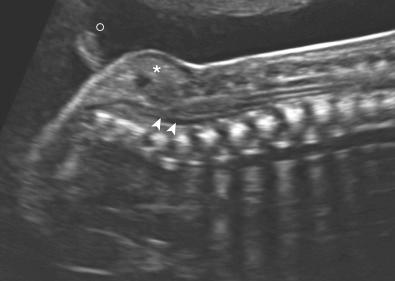
Diastematomyelia or split cord malformation describes the splitting of the lower thoracic or upper lumbar spinal cord into two hemicords by a bony or cartilaginous spur. The diagnosis is suggested by widening of the spinal canal in the coronal plane and an echogenic bony fragment underlying the intact skin ( Fig. 28.20 ). Other spinal malformations are often associated with this condition. The prognosis seems favourable in isolated cases.
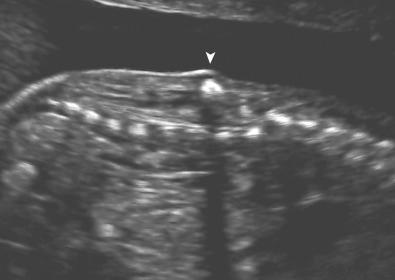
The development of the prosencephalon or forebrain into the telencephalic vesicles and the diencephalon results from a series of inductive processes starting at the fifth postovulatory week. The process of ventral induction responsible for the formation, cleavage and midline development of the prosencephalon also takes part in the formation of the midface. Defective development results in a variety of malformations often associated with facial involvement ( Table 28.6 ).
| Developmental Failure | Anomalies |
|---|---|
| Prosencephalic formation | Aprosencephaly |
| Atelencephaly | |
| Prosencephalic cleavage | Holoprosencephaly (involves diencephalon and telencephalon) |
| Holotelencephaly (involves telencephalon) | |
| Prosencephalic midline development | Agenesis or dysgenesis of the corpus callosum |
| Agenesis of septum pellucidum | |
| Septo-optic dysplasia |
Holoprosencephaly (HPE) is a complex and heterogeneous forebrain malformation. As a result of a ventral induction failure, the prosencephalic vesicle fails to divide into the telencephalic and diencephalic vesicles. In addition, the failed outgrowth of the frontonasal process is responsible for a variable degree of midfacial maldevelopment.
The incidence of holoprosencephaly is estimated at 1 in 6000 to 1 in 16,000 live births and at 1 in 250 in early conceptions. There is no male-to-female preponderance, nor a higher prevalence related to ethnicity. Table 28.7 lists the potential aetiologies.
| Group | Anomalies |
|---|---|
| Syndromal anomalies (18%–25%) | Smith-Lemli-Opitz syndrome |
| Pseudo trisomy 13 | |
| Meckel syndrome | |
| Steinfeld syndrome | |
| Chromosomal anomalies (35%–45%) | Trisomy 13 |
| Trisomy 18 | |
| Secondary to gene point mutations | SHH on 7q36 |
| ZIC2 on 13q32 | |
| SIX3 on 2p21 | |
| TGIF on 18p11.3 | |
| PCTH | |
| TDGF1 | |
| GLI2 | |
| FOXH1 | |
| NODAL | |
| DISP1 | |
| GAS1 | |
| FGF8 |
According to the degree of forebrain separation, four different types can be distinguished: alobar, semilobar, lobar and interhemispheric variant ( Table 28.8 ).
| Type of HPE | Ventricles | Midline Structures |
|---|---|---|
| Alobar | Single primitive ventricle Residual ‘brain mantle’
|
|
| Semilobar | Rudimentary lateral ventricles Rudimentary third ventricle |
|
| Lobar | Partial fusion of anterior horns with squared borders and flattened roof |
|
| Middle interhemispheric (syntelencephaly) |
|
|
Holoprosencephaly often presents with a variable degree of midfacial maldevelopment, ranging from cyclopia and proboscis, severe hypotelorism and ethmocephaly, to arhinencephaly and a normal-appearing face. Occasionally, the sole indicator might be a single incisor.
The diagnosis of semilobar and alobar HPE is feasible from the first trimester of pregnancy by either transabdominal or transvaginal ultrasound ( Figs. 28.21 and 28.22 ).
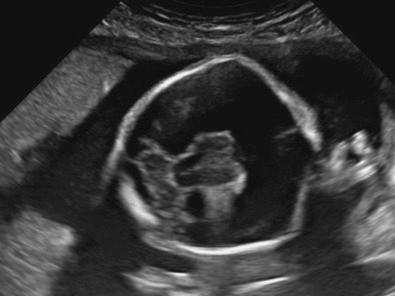
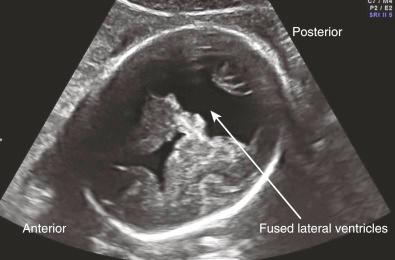
Three-dimensional ultrasound, inversion mode rendering or 3D sono-automated volume count (AVC) of the ventricular system and sonographic tomographic imaging may be helpful in defining the severity of the malformation and characterising facial malformations. MRI is of great additional value in depicting the features that differentiate abnormal brain formation and aids in the diagnosis and counselling of these cleavage disorders, which have a different prognosis depending on the severity of failure of ventral induction.
Because of its frequent association with chromosomal malformations, fetal karyotyping or comparative genomic hybridisation (CGH) should be offered routinely. The most frequently encountered chromosomal malformations are trisomy 13, del (13q), del (18p), trisomy 18, triploidy, dup (3p) and del (7) (pter+q32).) The high risk for syndromic HPE demands a search for additional structural anomalies; therefore a pathological investigation is recommended.
The empiric recurrence risk for HPE is 5% to 6%. If HPE occurs in the context of a chromosomal anomaly; the recurrence risk is usually less than 1%. In syndromic forms, the recurrence rates may increase up to 25% to 50%. Dominant inheritance with reduced penetrance explains the inheritance pattern of familial HPE.
The outcome of the different types of HPE has been summarised in Table 28.9 . TOP is usually offered for alobar, semilobar and interhemispheric forms of HPE.
| Mortality |
|
| Neurologic impairment |
|
| Morbidity |
|
The CC is the major commissure between the two cerebral hemispheres and plays an important role in the integration of information between the hemispheres. At about 12 weeks’ gestational age, the CC starts to develop from the lamina terminalis as a bundle of fibres that connects the two hemispheres. The development of the CC is closely related to the normal appearance of the septa pellucida. Anterior to the foramina of Monroe, the space between the septa is called the cavum cave septi pellucidi (CSP); posterior to this structure, it is referred to as the cavum vergae (CV) The CC, which is composed of four segments, starts developing from the 11th week of gestation with the genu, and subsequently the body, isthmus and splenium form. The rostrum, the most anterior part, develops later. Completion of the CC is achieved by 18 to 20 weeks of gestation. At the median surface of the cerebrum, the gyrus cinguli creates a partial girdle around the CC and follows the callosal curve.
Normal sonographic development of the anterior and posterior complex in the axial plane indicate adequate midline development; however, morphologic abnormality in both complexes is a strong indicator for midline abnormalities and cortical malformations. The midsagittal and the coronal views are the best planes to directly visualise the CC. In a midsagittal two-dimensional view, the CC appears as a thin anechoic space, delineated superiorly and inferiorly by two smooth echogenic lines. The complete visualisation and measurement of the CC is feasible from 18 weeks’ gestation onwards. Normative charts can be used to evaluate the length and thickness of the CC. Transvaginal ultrasound, multiplanar 3D and three-dimensional volume contrast imaging in the C-plane (VCI-C) imaging facilitate the proper identification. The midsagittal plane reveals the CC with all its neighbouring structures; the CSP, the CV, the cavum veli interpositi and the cingulate gyrus. Using colour-flow Doppler, the anterior cerebral and pericallosal arteries with their branches and the vein of Galen are easily displayed in the early second trimester.
The terminology to describe CC dysgenesis includes complete and partial agenesis, hypoplasia (thinning of the CC), hyperplasia (thickening of the CC) and morphologically oddly shaped CC. A prevalence of 1.4 and 0.4 per 10,000 live births for ACC and hypoplasia of the CC has been suggested, respectively. These figures may be an underestimate as a proportion of asymptomatic ACC patients escape detection.
Complete absence of the CC (ACC) results in an abnormal induction of medial cerebral convolutions determining a radiate arrangement of the cerebral sulci around the roof of the third ventricle. With ACC, the semicircular loop of the pericallosal artery is lost, and branches of the anterior cerebral artery ascend linearly with a radial arrangement. ACC has been associated with other cranial anomalies, such as abnormalities of the posterior fossa and interhemispheric cyst and neuronal migration disorders. Because the development of the CC coincides with cortical development, lissencephaly, heterotopia, polymicrogyria (PMG) and schizencephaly are often present. The rate of chromosomal anomalies is estimated at about 17.8%, including microdeletions for which array comparative genomic hybridisation might be considered. In addition, ACC-linked syndromes show an autosomal dominant, recessive or X-linked mode of inheritance. An OMIM (Online Mendelian Inheritance in Man) search results in more than 200 entries, of which Aicardi and Andermann syndromes are the more common. Occasionally, a metabolic aetiology is found, such as hyperglycemia without ketose, a pyruvate dehydrogenase deficiency or phenylketonuria.
Indirect sonographic features are often helpful when screening for the absence of the CC. The absent CSP should raise suspicion, and dilation of the atria and occipital horns (colpocephaly) shaping the lateral ventricles like teardrops is very suggestive for CCA ( Fig. 28.23A ). There is, however, no progressive VM. On a coronal view, the lateral ventricles are displaced laterally because of the failure of the bundles of Probst to cross the midline, making the anterior parts of the lateral ventricles look like bull’s horns. Often the third ventricle is enlarged and extends posterior and cranially. Because of the lack of communicating fibres, there is an increased distance between both hemispheres ( Fig. 28.23B ), which shows in the axial plane as three parallel lines: the falx cerebri and the medial borders of the two hemispheres. However, at the time of midtrimester ultrasound screening, indirect signs may be either absent or barely visible but may appear more clearly later in gestation. In a sagittal view, ACC results in an abnormal induction of the medial cerebral convolutions, leading to a radial arrangement of the sulci, strengthened by the hypoplasia or absence of the cingulate gyrus. By colour-flow Doppler, the pericallosal arteries display an irregular radiant vascular pattern ( Figs. 28.24 and 28.25 ).

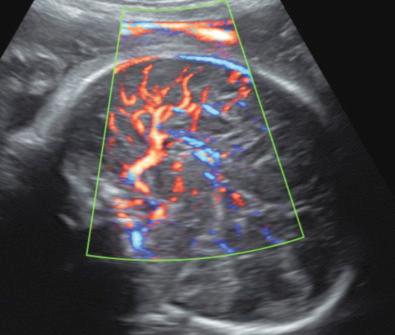
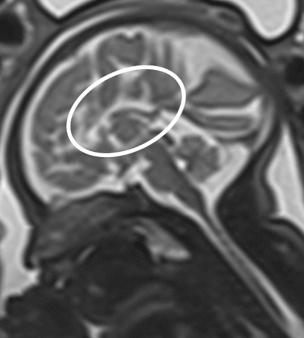
In partial ACC, the CSP is usually present but is abnormally shaped. Only the midsagittal views of the fetal brain allows for the differentiation among complete agenesis, hypoplasia or partial formation of the CC ( Fig. 28.26 ). In hypoplasia of the CC, often the posterior portion is affected. Only a handful of cases have been detected prenatally.
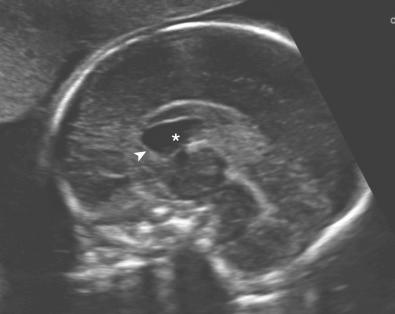
The pericallosal artery follows the anterior part of the CC but loses its normal course posteriorly.
A thick CC is identified in 5% of CC abnormalities. It can be associated with macrocephaly, macrocephaly-capillary syndrome and Cohen syndrome.
Hyperechogenicity of the CC is characteristic of pericallosal lipoma which is often isolated. Sometimes it is part of a frontonasal dysplasia, Goldenhar syndrome or Pai syndrome. Because of the association with chromosomal abnormalities of various kinds, array CGH is highly recommended. In addition to the fetal neurosonogram, a detailed examination of all fetal organ systems, especially the fetal heart, the genitourinary system and the skeleton, should be performed.
The identification by means of fetal MRI of more discrete CNS lesion (≤22.5%) such as abnormal gyration, heterotopia and migration anomalies in association with CCA enables refinement of the diagnosis and prognosis. MR is less accurate in measuring thickness of the CC because of the low spatial resolution of MRI. Subjective callosal thickening should alert the specialist, and additional abnormalities should be looked for. In addition, new MRI techniques such as fibre tracking and functional MRI may help to differentiate isolated cases with usually a good prognosis from those with additional cerebral lesions and an adverse outcome.
Significant neurodevelopmental delay may occur in 15% to 36% of the cases of isolated CCA. The presence of other cerebral and extracerebral malformations worsens the neurodevelopmental outcome. A systematic review assessing the of neurodevelopmental outcome in 132 fetuses revealed a normal outcome in 74.3% with complete CCA and in 65.5% of partial CCA. Moderate and severe disability was reported in 14.3% and 11.4% of CCA and in 6.9% and 27.6% of partial CCA, respectively. Subtle perceptual, neuropsychological and motor defects may arise later in life.
Of major importance, an additional 15% of prenatally isolated ACC cases were found to have associated problems after birth. At the age of 10 years, 75% of the children have a normal intelligence but frequently with mild learning difficulties.
Absence of the CSP occurs in about 0.2 to 0.3 per 10,000 pregnancies. The CSP appears as a fluid-filled box on an axial plane between the frontal horns, the CC and the thalami. In a sagittal plane, it is localised under the anterior part of the CC. The CSP is square in 73% and triangular in 27%; however, in cases with CV, the appearance is rectangular. The mean width at midtrimester is 3.4 mm. The CSP progressively decreases in size from 26 weeks of gestation. By term, the closure of the CSP is seen in 97% of fetuses, although occasionally, this cavity remains open until adulthood. Failure to visualise the CSP between 18 and 37 weeks is highly indicative of cerebral anomalies. Although it may occur as a normal variant if isolated, absence may be associated with the HPE spectrum, septo-optic dysplasia (SOD), callosal dysgenesis and hypogenesis, chronic severe hydrocephalus resulting from aqueductal stenosis or CM, schizencephaly, porencephaly or hydranencephaly and basilar encephaloceles. Genetic causes are rare. The persistence of an enlarged CSP (>1cm) beyond infancy has been associated with cerebral dysgenesis.
Septo-optic dysplasia can be suspected when the CSP is absent in an otherwise normal brain ( Fig. 28.27 ). The frontal horns are fused at the midline, and the CC is frequently thin. VM can be present. In experienced hands, sonographic 3D visualisation and measurement of the chiasma and optic nerves may confirm the diagnosis. Fetal MRI is generally more suited to exclude optic tract hypoplasia. Additional endocrinologic evaluation and visual assessment are mandatory to differentiate from isolated absent CSP. The prognosis of an isolated absent CSP is usually good. In nonisolated cases, the prognosis is related to the associated conditions. The recurrence risk for isolated absent CSP is low, but in a few cases, Mendelian inheritance is suggested.
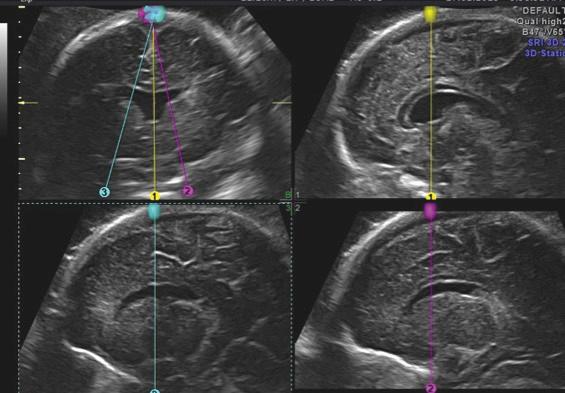
Become a Clinical Tree membership for Full access and enjoy Unlimited articles
If you are a member. Log in here